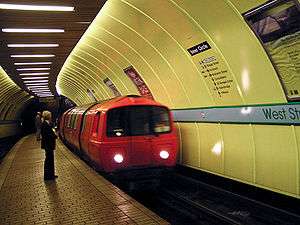1980 in rail transport
| Years in rail transport |
This article lists events related to rail transport that occurred in 1980.
Events
January
- January 7 – The Dunmurry train explosion takes place on board a Ballymena to Belfast passenger train service, when a Provisional Irish Republican Army (IRA) incendiary bomb exploded prematurely, killing three people.
- January 23 – Western Pacific Railroad president R. G. "Mike" Flannery announces that an agreement has been reached for the railroad to be controlled by Union Pacific Railroad.[1]
February
- February 20 – Canadian Pacific Railway officially abandons its Eganville subdivision, including tracks between Payne and Douglas, Ontario.[2]
March
- March 1 – The Milwaukee Road ends operations on all points west of Miles City, Montana, shutting down nearly half of the railroad.
- March 31 – The Chicago, Rock Island and Pacific Railroad (the Rock Island) ceases operations.
April

Glasgow Subway as rebuilt
- April 16 – After a complete system overhaul, the Glasgow Subway is reopened.
May
- May – Massachusetts Bay Transportation Authority extends passenger service to Concord, New Hampshire.
- May – The Interstate Commerce Commission approves the liquidation of the Rock Island Railroad; at 7,073 track miles covering 13 states, it is the largest such action in United States history.
June
- June 1
- The Oslo Tunnel opens, connecting the eastern and western rail networks of Norway.
- A new rail link opens between the city of Zürich and Zürich International Airport
July
- July 25 – Winsum train disaster, two trains collide on a single track between Groningen and Roodeschool, near Winsum, Netherlands, resulting in 9 deaths and 21 injured.
- July 31 – Boston and Maine Railroad, 2 men struck on track 16 inbound to Wakefield. Conductor Damian Soto, suspended 30 days without pay and forced to retake conductor license.
August
- August 1 – Buttevant Rail Disaster in Ireland, a train derails en route from Dublin to Cork, killing 17 passengers.
- August 2 – Bologna bombing: a terrorist bomb explodes at Bologna Central Station in Italy, killing 85.[3]
- August 3 – Amtrak introduces the Willamette Valley Express passenger train between Portland and Eugene, Oregon.
- August 11 – In England, the Tyne and Wear Metro opens for full public service with the first section from Haymarket to Tynemouth via South Gosforth and Four Lane Ends, the first British conversion from heavy to light rail.[4]
- August 19 – The Otloczyn railway accident occurred near the village of Otłoczyn (Kuyavian-Pomeranian Voivodeship, northern Poland) which killed 67 people and injured 64 more.
October
- October 9 – Official opening of new standard gauge line from Tarcoola, South Australia to Alice Springs as part of the Adelaide–Darwin railway project.[5]
- October 14 – U.S. President Jimmy Carter signs the Staggers Rail Act into law, significantly deregulating the American railroad industry.[5]
November
- November 21 – The Burlington Northern Railroad acquires the St. Louis - San Francisco Railway.[6]
- November – The Chessie System and Seaboard System Railroad merge to form CSX Transportation.[5]
- November – The first test runs of the Joetsu Shinkansen between Tokyo and Niigata are operated.
December
- December 3 – The Northwestern Steel and Wire mill in Sterling, Illinois, operates a steam locomotive (Baldwin 0-8-0 #73) for the last time, the final commercial use in the United States.[7]
Unknown date
- Now owning a 98.34% control of the Cotton Belt Railroad, the Southern Pacific Railroad extends the Cotton Belt to Chicago, Illinois, through acquisition of the former Rock Island Railroad.
- The last train, controlled by Conrail, operates on New York City's former New York Central "High Line" on the West Side. It was reported to have hauled three boxcars of frozen poultry.
- L. Stanley Crane[8][9] is succeeded by Harold H. Hall as president of the Southern Railway.
Accidents
References
- ↑ Feather River Rail Society/Western Pacific Railroad Historical Society (2002). "Western Pacific History". Archived from the original on 23 July 2013. Retrieved January 23, 2006.
- ↑ "Significant dates in Ottawa railway history". Colin Churcher's Railway Pages. February 17, 2006. Retrieved February 20, 2006.
- ↑ Williams, Anne; Head, Vivian (2006). Terror Attacks. London: Futura. pp. 286–93. ISBN 978-0-7088-0783-5.
- ↑ Gillham, J. C. (1988). The Age of the Electric Train: Electric Trains in Britain since 1883. London: Ian Allan. ISBN 0-7110-1392-6.
- 1 2 3 Balkwill, Richard; Marshall, John (1993). The Guinness Book of Railway Facts and Feats (6th ed.). Enfield: Guinness Publishing. ISBN 0-85112-707-X.
- ↑ Werner, George C. "Burlington System". The Handbook of Texas Online. Retrieved June 6, 2010.
- ↑ "Last locomotive to operate in the United States". Library Service of Northern Illinois University. Retrieved November 5, 2007.
- ↑ L. Stanley Crane, elected in 1978 as a member of the United States National Academy of Engineering
- ↑ L. Stanley Crane (born in Cincinnati, 1915) raised in Washington, lived in McLean before moving to Philadelphia in 1981. He began his career with Southern Railway after graduating from The George Washington University with a chemical engineering degree in 1938. He worked for the railroad, except for a stint from 1959 to 1961 with the Pennsylvania Railroad, until reaching the company's mandatory retirement age in 1980. Crane went to Conrail in 1981 after a distinguished career that had seen him rise to the position of CEO at the Southern Railway. He died of pneumonia on July 15, 2003 at a hospice in Boynton Beach, Fla.
Bibliography
- "Norfolk Southern Railway". Archived from the original on February 6, 2005. Retrieved December 7, 2015.
- "Trains Timetable". Trains Magazine. p. 14. May 2005.
This article is issued from Wikipedia - version of the 4/11/2016. The text is available under the Creative Commons Attribution/Share Alike but additional terms may apply for the media files.